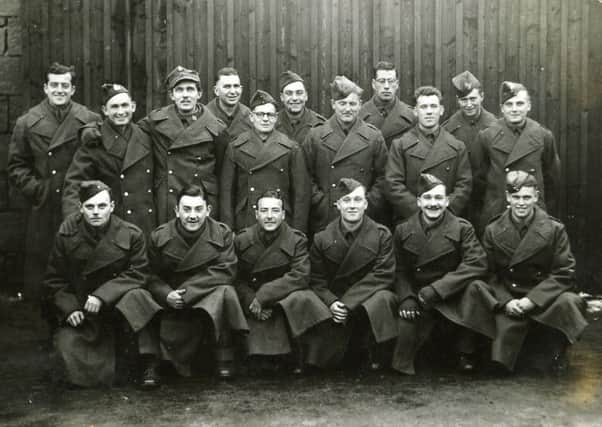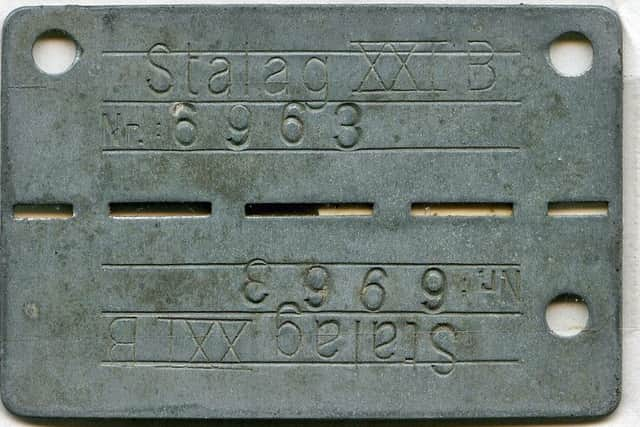Leeds nostalgia: Seven men to one load of bread: the life of a British POW


Harry was deployed to France in January 1940 and was captured at Dunkirk on June 12. His diary came to light after he died aged 96 in February. This week he tells of life under German rule...
“It was still dark when we were roused and marched out. We could see very little. We met up again with the rest of the column in a large field, with a railway line alongside. Men began looking round for friends and collecting into little groups. A German officer told us to prepare for a three day railway journey and we would be given rations for three days - a loaf of bread between three men and a small piece of margarine. Three men to a loaf was considered good for one day, but not three. Some camps gave five to a loaf, others seven to a loaf and when we entered the gates of a camp in the early days the cry went up ‘How many to a loaf?’ This gave us a quick estimation of what sort of camp it was.
Advertisement
Hide AdAdvertisement
Hide Ad“We found ourselves in the small Polish town of Schubin (about 65 miles north-east of Poznan). A short distance out of the town we walked through the big double gates into the barbed wired compound of Schubin POW Camp, known as Stalag (XXI D). At this stage the International Red Cross was informed [of my status] - it was another three months before my family received news I was a POW.


“After almost three months without a wash or a bath, without, a change of clothing and unable to shave, covered in dust and sweat, we were infected with body lice. [We had to] search for lice twice a day. Dysentery was common. The toilet consisted of an open trench about five feet wide and 10 yards long. Running along the length of the trench was a pole on wooden supports about two feet from the ground. When using the toilet you sat on the pole and gripped it with both hands, but often you could only use one hand, the other was busy brushing off the flies, there were millions of them.
“The bread ration was seven men to a loaf. It worked out to be the width of the lead disc we had round our necks, plus a small measure of margarine - it was hardly enough for a growing lad.
“The thing that worried me most was my forced separation from [my beloved] Frances. How long was this separation going to be? How I wished I had made some firm commitment to her on my leave at Christmas 1939. The memories of Schubin Camp bring only sadness to me.
Advertisement
Hide AdAdvertisement
Hide Ad“We were moved to Ludwig Sauw, POW Camp for six weeks. One night, we were all called into the compound and out came all the guards standing facing us with loaded rifles. They had found some holes under the wire and believed someone had tried to escape. It was from this Camp they gave us our first post-card to send home, it was the beginning of September 1940. I believe this card arrived home in October 1940. It was a great relief when I sent the card.


“About the end of September 1940 we left this camp… the war had been going just one year the whole camp was full of rumours: England was being bombed into submission, peace negotiations were taking place, the war would be over by Christmas, prisoners of war were to be exchanged and we were all to be moved out of Schubin Camp. This last one was true.
“After that we were moved to Posen, the second city of Poland. After a fairly long walk we arrived at Fort V111 Stalag, built for the defence of Poland during the Napoleonic Wars.
“Foot-rags were square pieces of cloth issued by the Germans in place of socks. All of us wore foot-rags for nearly two years. The trick in wearing them was to put a foot on the cloth, bring a corner over the toes, bring the two corners over the sides of the foot, then bring the back corner up the heel and round the front, hold the four corners with one hand then slip on your boot. Put on properly they could be quite comfortable.
Advertisement
Hide AdAdvertisement
Hide Ad“We were fortunate, in arriving at Fort V111, to find a number of Navy men already there; they were most of the crew of the Submarine HMS. Salmon. They had things well organized and, while we were there, ran the camp in a most efficient way.
“On our first working party we were employed unloading railway lines from wagons at a railway siding. On this particular job we were given a bowl of soup at mid-day and there was always a rush to be first in the queue. It was possible then to eat the soup before the rest had finished and then hang around the soup boiler and hope to get an extra ladle of soup should there be any left. One of the German under-officers spotted what was going on and often when we were lined up for the soup he would reverse the queue so that the last became first. He thought this was a great joke and would roar with laughter.
“It was now February 1941. We marched away from Fort Vlll. We must have looked an odd lot in Dutch, Belgium, French and British uniforms, all with a mess tin fastened to our belts. We expected to be heading for the station, but no, we kept on the outskirts of Posen and after an hour or so arrived at our new camp Eichwaldo just in the suburbs of Posen. Our work was just down the road from the camp on an open stretch of waste land which at one time had been a sand quarry. Day after day we were breaking stones and bricks and loading them on to horse and carts. We were told it was to make a park which in later years I found to be true.”
Next week, in the final part of our serialisation of his diary, read how Harry Goodall survived to see the German surrender and was set free, only to fall into the hands of the advancing Russian Army.